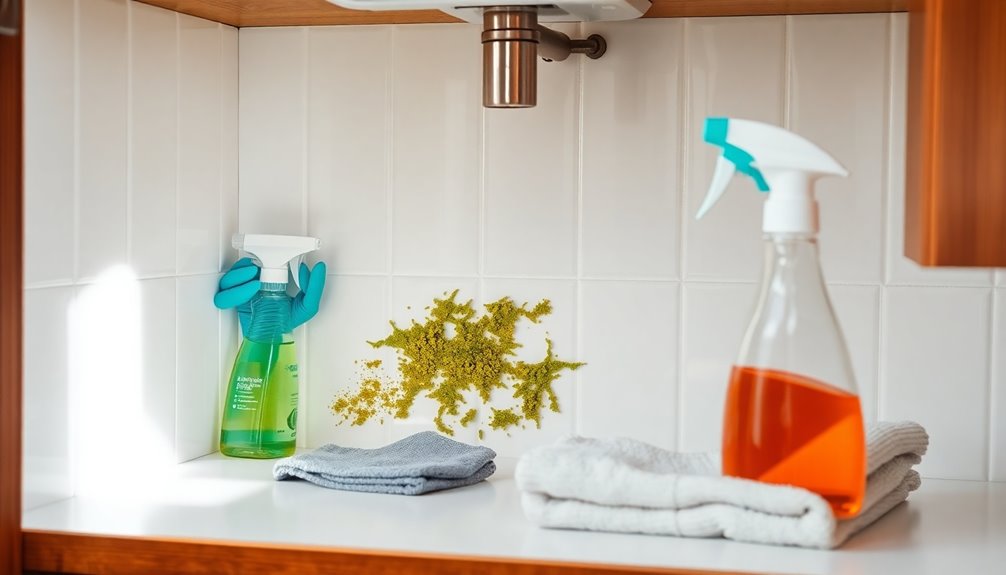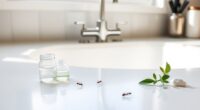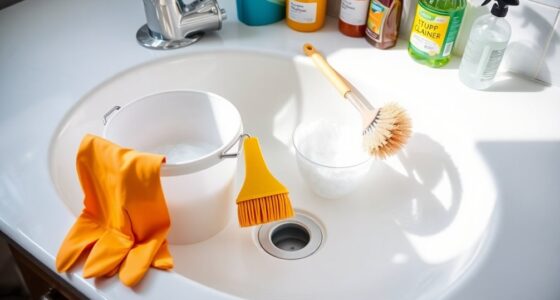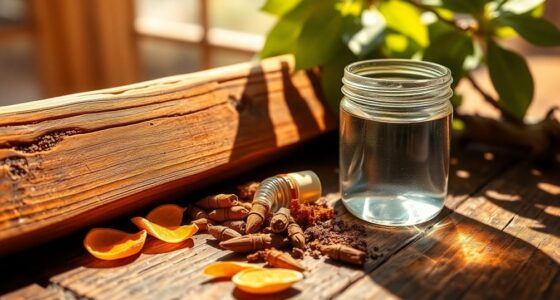To get rid of mold under your sink, start by identifying the source of moisture, like leaks or damp areas. Once you find the cause, clean the mold using solutions like hydrogen peroxide or vinegar. Don't forget to wear protective gear while you clean. For long-term prevention, keep humidity below 40% and ventilate the area well. If mold persists, you may face bigger issues. Continue for strategies to keep your home mold-free.
Key Takeaways
- Identify and fix any moisture sources, such as leaks in pipes or worn washers, to prevent mold from returning.
- Clean the affected area using a 3% hydrogen peroxide solution or full-strength white vinegar to eliminate mold.
- Wear protective gear, including gloves, a mask, and goggles, to ensure safety while cleaning mold.
- Improve ventilation by opening cabinet doors and using exhaust fans to reduce humidity and discourage mold growth.
- Regularly inspect and maintain the area, addressing moisture issues promptly to prevent future mold development.
Identifying the Source of Moisture
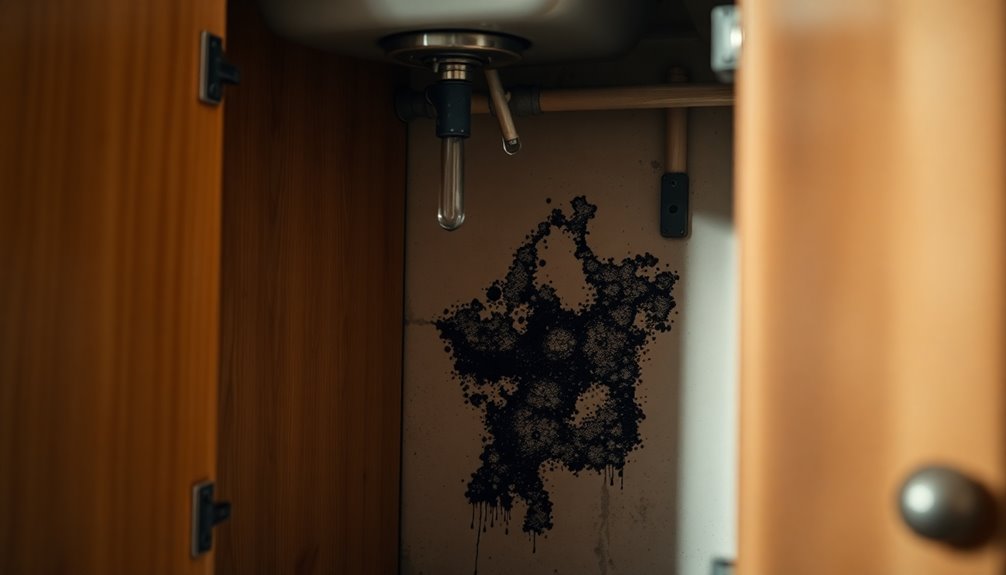
When you're trying to tackle mold under your sink, the first step is identifying the source of moisture. Mold thrives in damp, dark areas, making under-sink spaces particularly vulnerable.
Look for common moisture sources like pinhole leaks in drain pipes, worn washers on shut-off valves, or leaky plumbing behind cabinet walls.
Don't forget to check the garbage disposal housing; it can create persistent moisture issues. Regularly inspect dishwasher water connections too, as these can lead to further leaks.
By pinpointing and addressing these moisture sources, you'll not only prevent mold growth but also guarantee effective mold removal. If you're unsure, consider mold testing to confirm any hidden issues.
Taking these steps is essential for a healthier home.
How to Recognize Mold Under the Sink
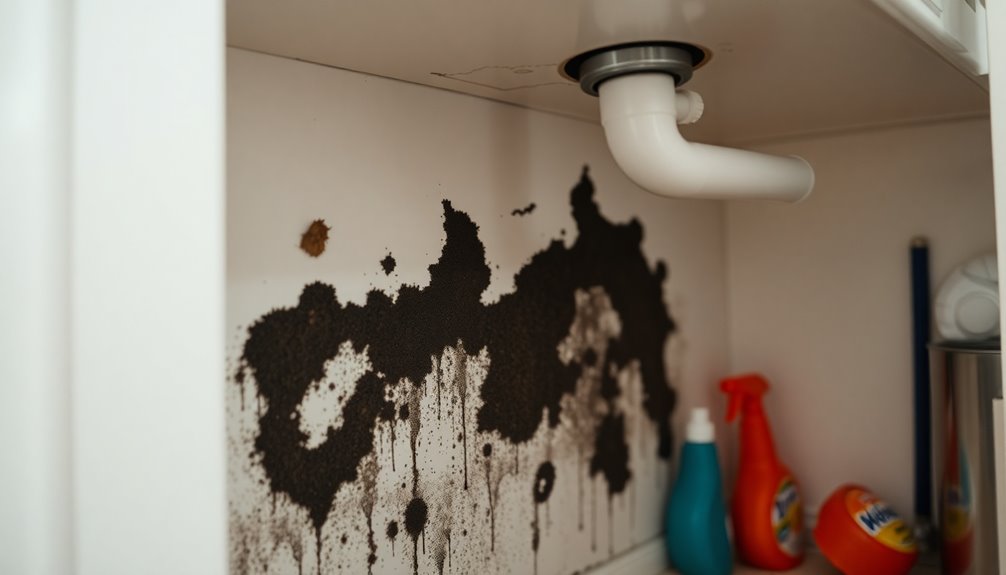
After addressing moisture sources, it's important to know how to recognize mold under the sink.
Look for discoloration in various colors like black, white, or fuzzy patterns, which often signal mold growth. A musty odor is another strong indicator.
Remember, mold thrives in warm, damp areas, especially where leaks or spills occur.
Check common surfaces like wood, cardboard, drywall, and grout, as mold spores can cling to these materials and may not be immediately visible.
Regularly inspect for signs of moisture, as early detection is key to preventing mold growth.
If you notice increased humidity in your home, take action quickly to minimize the risk of mold under the sink and throughout your living space.
Effective Cleaning Solutions for Mold

When tackling mold under your sink, choosing the right cleaning solution is key.
You can opt for natural agents like vinegar and baking soda or consider chemical solutions like hydrogen peroxide for tougher spots.
Understanding how to apply these methods effectively will help you eliminate mold and prevent it from returning.
Natural Cleaning Agents
Natural cleaning agents offer effective solutions for tackling mold under your sink without the harsh effects of chemicals.
Hydrogen peroxide, in a 3 percent solution, is a powerful option; just spray it directly on the mold, let it sit for about 10 minutes, and then scrub.
White vinegar, used full strength or mixed with warm water, not only inhibits mold growth but also neutralizes odors.
You can also create a baking soda solution—mix 1 teaspoon of baking soda in 1 cup of water—to clean mold safely while deodorizing the area.
Combining baking soda with vinegar boosts its cleaning power.
Regular use of these natural cleaning agents guarantees effective mold remediation, keeping your sink area fresh and mold-free.
Chemical Solutions Overview
While natural cleaning agents are great for tackling mold under your sink, you might also consider chemical solutions that offer powerful options for mold removal.
Hydrogen peroxide, in a 3 percent solution, effectively kills mold and is safe on various surfaces. White vinegar, used full strength or diluted, penetrates porous materials to disrupt mold growth without harsh chemicals.
Baking soda mixed with water not only cleans but also deodorizes, serving as a dual-purpose cleaning solution. For an enhanced effect, combine baking soda with white vinegar to lift mold more effectively.
However, avoid using bleach on porous materials, as it can worsen mold growth by adding moisture and is generally less effective. Regular cleaning with proper filtration systems can also help maintain a healthier environment and reduce mold spore accumulation.
These solutions can help remove mold and prevent mold from growing in your home.
Application Techniques
To effectively tackle mold under your sink, start by applying a suitable cleaning solution directly to the affected area. You can use hydrogen peroxide, white vinegar, or a baking soda paste. If the mold persists, consider using bleach, but guarantee you wear rubber gloves and keep the area well-ventilated. For stubborn patches, spray vinegar first, then sprinkle baking soda, allowing it to fizz before scrubbing. If you're unsure or uncomfortable, don't hesitate to seek professional help.
| Solution Type | Application Technique |
|---|---|
| Hydrogen Peroxide | Apply directly, let sit for 10 minutes |
| White Vinegar | Spray, scrub after 10 minutes |
| Baking Soda Paste | Mix 1 tsp in 1 cup water, scrub gently |
| Commercial Remover | Follow manufacturer's instructions |
Safety Measures When Handling Mold
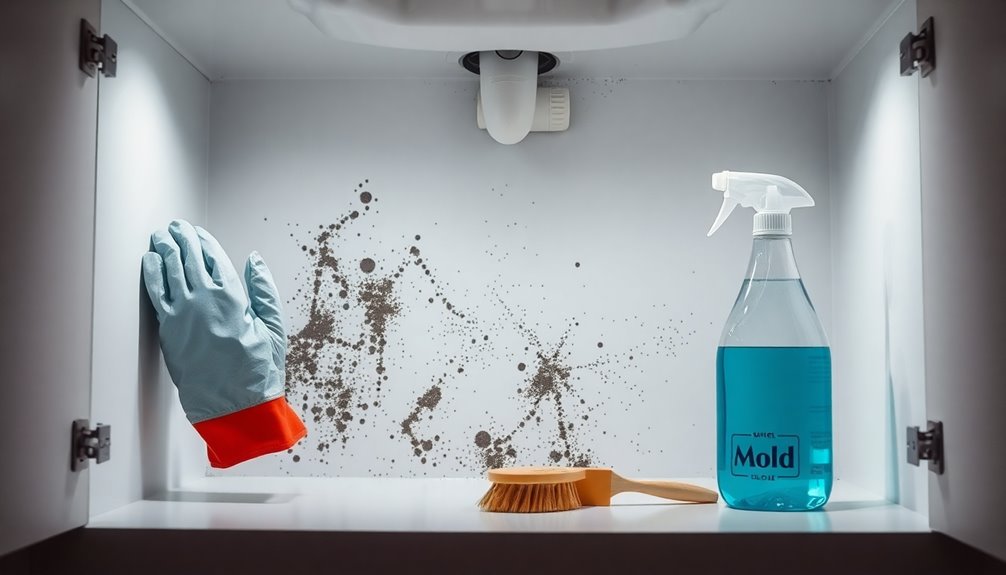
When tackling mold under your sink, it's essential to prioritize safety.
Make sure to wear protective gear, ventilate the area well, and dispose of any contaminated materials properly.
These steps will help you minimize exposure and prevent further mold spread.
Personal Protective Equipment
Protecting yourself is essential when dealing with mold, especially in tight spaces like under the sink.
Always wear a breathing mask to prevent inhaling mold spores that can lead to respiratory issues. Use rubber gloves to shield your skin from direct contact with mold and harsh cleaning solutions, which can cause irritation or allergic reactions.
Eye protection, such as goggles, is vital to guard your eyes against mold particles and any splashes from cleaning agents.
After you're done, make sure that your protective gear is either disposed of or cleaned properly to avoid spreading mold spores to other areas of your home.
Consider using disposable protective clothing to simplify cleanup and minimize contamination risk during the mold removal process.
Proper Ventilation Techniques
Having the right personal protective equipment is just the first step in combating mold under your sink. Proper ventilation techniques are essential to inhibit mold growth.
Start by opening sink cabinet doors to enhance air circulation, allowing moisture to escape. Installing a small exhaust fan can greatly improve airflow and help dry out moisture-prone areas. Aim to keep humidity levels below 40%, as this deters mold development.
Regularly check and maintain your kitchen's ventilation systems to guarantee they're functioning effectively. Consider using dehumidifiers in damp areas, and incorporate ventilation grilles or passive vents in cabinetry to further reduce the chances of mold thriving in those dark, enclosed spaces. Additionally, understanding the impact of location on assisted living costs can provide insight into the importance of maintaining a healthy environment at home.
Your proactive approach will make a big difference in keeping mold at bay.
Safe Disposal Methods
Dealing with mold requires careful attention, especially during disposal. You need to prioritize safety when handling mold-infested materials.
Here are some safe disposal methods to follow:
- Wear protective gear: Always use gloves, a breathing mask, and eye protection to minimize health risks.
- Seal items properly: Place moldy materials in plastic bags to prevent spore spread during removal.
- Follow local regulations: Dispose of items according to your area's hazardous waste guidelines, avoiding mixing moldy items with regular waste.
If the infestation is extensive or you're unsure about handling it, consider hiring a commercial mold disposal service.
Taking these precautions helps guarantee your safety and protects the environment.
Long-term Prevention Strategies
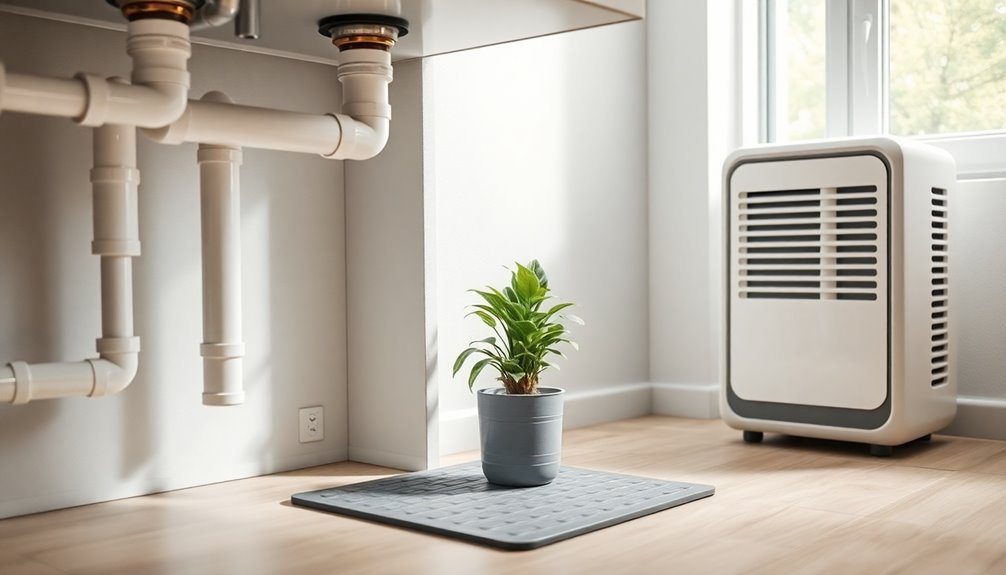
To keep mold from making itself at home under your sink, it is essential to adopt proactive long-term prevention strategies. Regularly inspect the area for leaks and moisture buildup, addressing any issues immediately to help prevent mold growth. Maintain indoor humidity levels below 40% using dehumidifiers or air conditioning. Installing ventilation fans in kitchen cabinets promotes airflow, reducing water damage risks. Using waterproof mats under the sink protects surfaces and makes cleaning easier. Schedule routine cleanings with mold-inhibiting solutions to keep the space healthy.
| Strategy | Purpose | Frequency |
|---|---|---|
| Inspect for leaks | Prevent mold growth | Monthly |
| Use dehumidifiers | Control humidity | Year-round |
| Clean with mold inhibitors | Maintain a healthy space | Bi-weekly |
When to Seek Professional Help

Recognizing when to seek professional help for mold under your sink is essential, especially if the affected area exceeds 3 square feet. Ignoring this can lead to serious health risks.
Here are three signs you need expert assistance:
- You see visible black and slimy mold, which could be toxic.
- You or someone in your household has asthma or mold allergies.
- The mold is in hard-to-reach areas, requiring specialized equipment.
In these cases, professional mold remediation is vital. Certified specialists can identify moisture sources and apply effective treatments, ensuring your home is safe.
Don't hesitate to ask for help—your health and safety matter!
Frequently Asked Questions
How Do You Get Rid of Black Mold Under the Sink?
To tackle black mold under the sink, first, you'll need to address the moisture source—check for leaks.
Wear protective gear like gloves and a mask to stay safe.
Use a vinegar-water mix or hydrogen peroxide to spray the moldy area, letting it sit for an hour.
Scrub with a brush, rinsing often to prevent spreading spores.
Finally, make sure everything dries thoroughly to stop mold from returning.
If it's extensive, consider calling a pro.
How Do I Stop Mold From Growing Under My Sink?
To stop mold from growing under your sink, start by regularly checking for leaks and moisture.
Fix any leaks immediately. Keep indoor humidity below 40% with dehumidifiers or air conditioning.
Use mold inhibitors on surfaces that get damp, and guarantee good ventilation by occasionally leaving cabinet doors open.
Store liquids in sealed containers and clean the area often to eliminate spills or debris that could feed mold growth.
Is Mold Under the Sink Toxic?
Yes, mold under your sink can be toxic. Certain types, like black mold, release harmful mycotoxins that may lead to respiratory issues and allergic reactions, especially if you have pre-existing health conditions.
Prolonged exposure can cause more severe health problems, including chronic fatigue and headaches. It's essential to address any mold growth quickly to protect your health and prevent further complications.
Don't ignore it; take action as soon as you notice it.
Is Vinegar or Bleach Better for Killing Mold?
When it comes to killing mold, vinegar's your best bet. Its acetic acid effectively tackles around 82% of mold species, making it a powerful option.
Unlike bleach, vinegar penetrates porous surfaces like wood and drywall, ensuring a thorough clean. Plus, it's safer for indoor use, especially if you have kids or pets.
You can even mix it with baking soda for an extra boost against stubborn stains without harsh chemicals.
Conclusion
In your quest to banish mold from under your sink, remember that prevention is key—much like keeping a castle free from invaders. By identifying moisture sources, using effective cleaning solutions, and maintaining vigilant habits, you can protect your home from these persistent foes. Don't hesitate to seek help if the mold persists, as sometimes even the bravest knights need reinforcements. With a proactive approach, you can keep your castle clean and mold-free for good!
